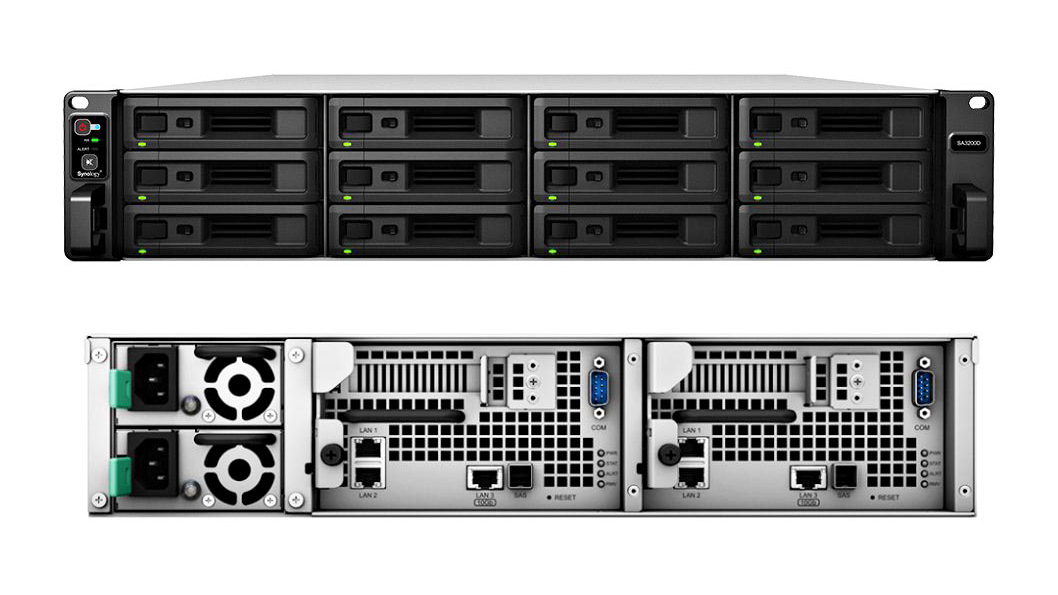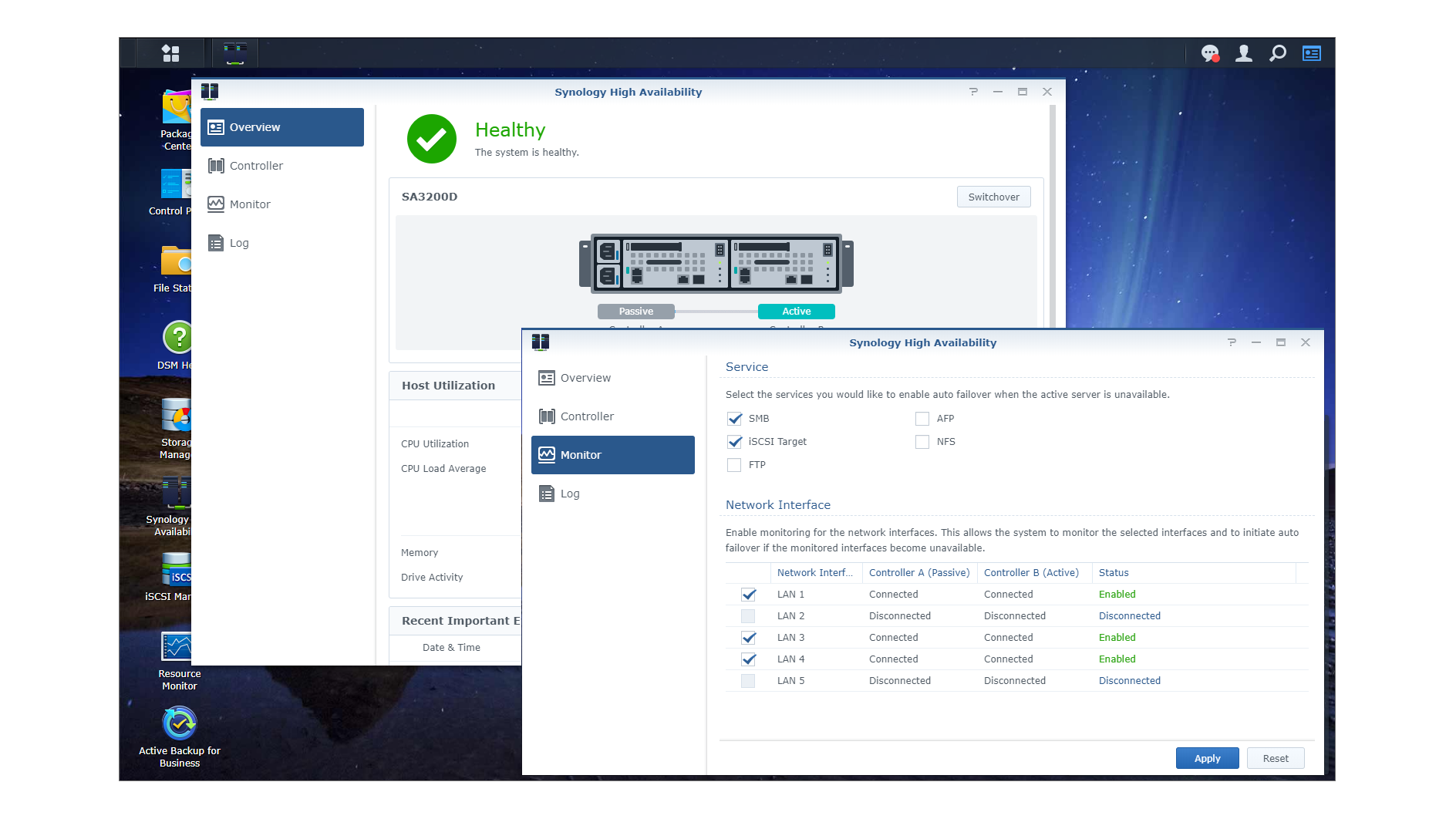Synology SA3200D review: Storage duality for SMBs
Synology delivers affordable highly available storage, although automatic failover isn’t transparent


-
+
Good value
-
+
End-to-end hardware redundancy
-
+
Sub-one minute failover
-
+
Great 10GbE performance
-
+
Wealth of data protection features
-
-
Noisy cooling fans

Synology’s SA3200D aims to deliver fault-tolerant network storage services at a price that will appeal to SMBs. The company has recently shown an increased interest in high availability solutions and the SA3200D follows closely on the heels of the IT Pro-approved UC3200 appliance.
Physically, there’s nothing to tell them apart as both employ the same 2U 12-bay rack chassis with dual controllers and support for SATA/SAS3 HDDs and SSDs. However, whereas the UC3200 runs its controllers in active/active mode for transparent failover, the SA3200D spins them up as an active/passive cluster so failover will interrupt all storage services.
The UC3200 costs around £1,300 less and the reason is it only provides IP SAN services along with LUN snapshots and replication. The SA3200D delivers the full NAS and IP SAN storage works, and can run every feature, app and service available in Synology’s DSM software.
Synology SA3200D review: Controllers and failover features
The SA3200D uses exactly the same controllers as the UC3200. Each is powered by a quad-core 2.4GHz Intel Xeon D-1521 CPU, teamed up with 8GB of DDR4 ECC memory that can be boosted to 64GB.
Data ports comprise dual Gigabit and one 10GBase-T which can be increased further. Each controller has a spare PCI-E slot, while their SAS3 ports can be used to daisy-chain a maximum of two 12-bay RXD1219sas disk shelves. The controllers are each cooled by dual on-board cold-swap fans and come in for the same criticism as the UC3200; even on the DSM ‘quiet’ mode, they’re as noisy as a small vacuum cleaner.
The appliance uses the standard Synology High Availability (SHA) app to provide failover services. This is freely available for all Synology business-class appliances and allows you to create a high availability cluster across two identical models using their network ports for cluster and heartbeat connections.
This method is also used by Synology’s 5-year old RC18015xs+ solution but the SA3200D is far superior as it’s a self-contained unit and is substantially better value. Another key advantage is its controllers are linked internally over an NTB (non-transparent bridge) connection so failover will be a lot faster as all heartbeat and cluster connections are implemented in hardware.
Synology SA3200D review: Deployment and data protection
Deployment is no different to Synology’s standard NAS appliances - we used the Web Assistant to discover the appliance and load the DSM software on both controllers. For testing, we fitted 6TB Toshiba Enterprise SAS3 HDDs and 400GB Seagate Nytro SAS3 SSDs and used the Storage Manager app to create a RAID5 array with a mirrored SSD read/write cache assigned.

Along with a wealth of NAS and IP SAN services, Synology’s DSM software is positively brimming with data protection features. The Hyper Backup app manages local, remote, Rsync, cloud and iSCSI LUN backups while the Drive app provides Dropbox-like sync services for Windows workstations plus iOS and Android mobiles.
The Snapshot Replication app supports manual and scheduled NAS and IP SAN snapshots on BTRFS volumes and offers fast recovery services. LUN snapshots can also be managed from the iSCSI Manager app and data recovery is a cinch as you choose a snapshot, clone it or copy it in place.
Synology’s Active Backup for Business (ABB) app is a class act,providing backup, restore and disaster recovery services for Windows servers and workstations along with agentless backup for VMware vCentre and ESXi hypervisors plus Windows Server 2016/2019 Hyper-V hosts. Managed from a single console, ABB provides backup scheduling along with slick file and folder plus bare-metal system restore facilities.
Synology SA3200D review: Failover testing
For failover testing, we called up a Dell PowerEdge T640 Xeon Scalable tower server running Windows Server 2019 and hooked up to the SA3200D over 10GbE. We set up a continuous Ping on the appliance’s data port and also created an ABB job to secure the entire server.
From the SHA app, we initiated a switchover from the active controller A to the passive controller B. As soon as the app set this in motion, we saw the ABB backup job stop and post a log entry saying it had been cancelled.
Iometer lost contact with the appliance five seconds later and it was a further 42 seconds before contact was re-established and all services had been switched over. As we demonstrated, the active/passive will cause all jobs using the appliance to fail but the process is as fast as Synology claims.
It does require manual intervention, but we were able to restart the ABB backup job which continued to completion. Failover is also a lot faster than the RC18015xs+ as when we tested it way back in 2015, we found it took 90 seconds to restore all services.
Synology SA3200D review: Storage performance
With a share mapped to the Dell T640 test server, we found overall 10GbE performance to be very good with Iometer reporting raw sequential read and write speeds of 9.2Gbits/sec and 8.1Gbits/sec. It was the same story for our real world tests as drag and drop copies of a 25GB test file returned average read and write rates of 5Gbits/sec and 4.6Gbits/sec.

Our backup test was handled well with a 22.4GB folder holding 10,500 small files secured to the share at a speedy 2.1Gbits/sec. The SA3200D has no problem handling encryption as copying the 25GB test file to an encrypted folder averaged 2.2Gbits/sec.
IP SAN performance is equally good with a 500GB iSCSI target returning Iometer read and write rates of 9.1Gbits/sec and 8.1Gbits/sec. After fitting Emulex dual-port 10GBase-T cards in the controllers, we created a dual 10GbE MPIO link to the target and saw speeds increase to 18.1Gbits/sec and 10.4Gbits/sec.
Synology SA3200D review: Verdict
The SA3200D delivers highly available NAS and IP SAN storage in a self-contained appliance at an affordable price. Storage services will be stopped briefly during failover, but our tests show the switchover from active to passive controllers is fast and the appliance is capable of running everything Synology’s DSM software has to offer.
Synology SA3200D specifications
| Chassis | 2U rack |
| Storage | 12 x SAS3 LFF/SFF hot-swap drive bays |
| Power | 2 x 500W hot-plug PSUs |
| Controllers | Dual active/passive controllers each with the following: |
| CPU | 2.4GHz 4-core Intel Xeon D-1521 |
| Memory | 8GB DDR4 ECC (max 64GB) |
| Array support | RAID 0, 1, 10, 5, 6, F1 |
| Network | 2 x Gigabit, 1 x 10Gbase-T |
| Expansion | 1 x PCI-E Gen3 x8, 1 x SAS3 |
| Management | Web browser |
| Warranty | 5-year limited |
Get the ITPro daily newsletter
Sign up today and you will receive a free copy of our Future Focus 2025 report - the leading guidance on AI, cybersecurity and other IT challenges as per 700+ senior executives
Dave is an IT consultant and freelance journalist specialising in hands-on reviews of computer networking products covering all market sectors from small businesses to enterprises. Founder of Binary Testing Ltd – the UK’s premier independent network testing laboratory - Dave has over 45 years of experience in the IT industry.
Dave has produced many thousands of in-depth business networking product reviews from his lab which have been reproduced globally. Writing for ITPro and its sister title, PC Pro, he covers all areas of business IT infrastructure, including servers, storage, network security, data protection, cloud, infrastructure and services.
-
 Cleo attack victim list grows as Hertz confirms customer data stolen – and security experts say it won't be the last
Cleo attack victim list grows as Hertz confirms customer data stolen – and security experts say it won't be the lastNews Hertz has confirmed it suffered a data breach as a result of the Cleo zero-day vulnerability in late 2024, with the car rental giant warning that customer data was stolen.
By Ross Kelly Published
-
 Women show more team spirit when it comes to cybersecurity, yet they're still missing out on opportunities
Women show more team spirit when it comes to cybersecurity, yet they're still missing out on opportunitiesNews While they're more likely to believe that responsibility should be shared, women are less likely to get the necessary training
By Emma Woollacott Published
-
 OpenAI wants developers using its new GPT-4.1 models – but how do they compare to Claude and Gemini on coding tasks?
OpenAI wants developers using its new GPT-4.1 models – but how do they compare to Claude and Gemini on coding tasks?News OpenAI says its GPT-4.1 model family offers sizable improvements for coding, but tests show competitors still outperform it in key areas.
By Ross Kelly Published